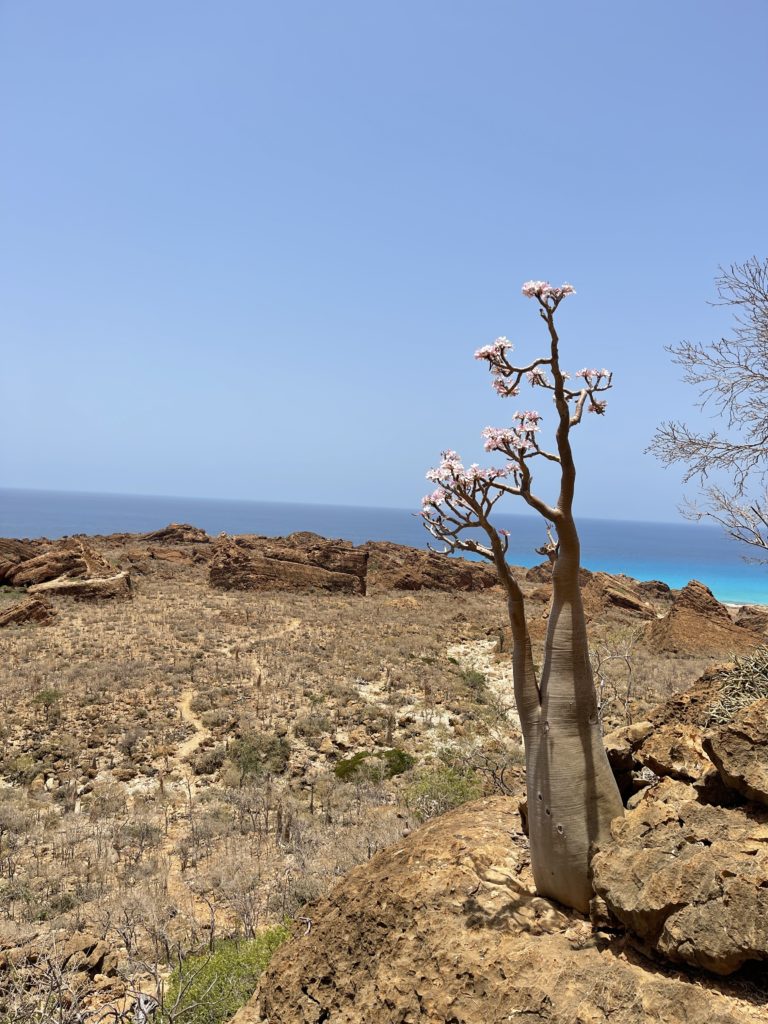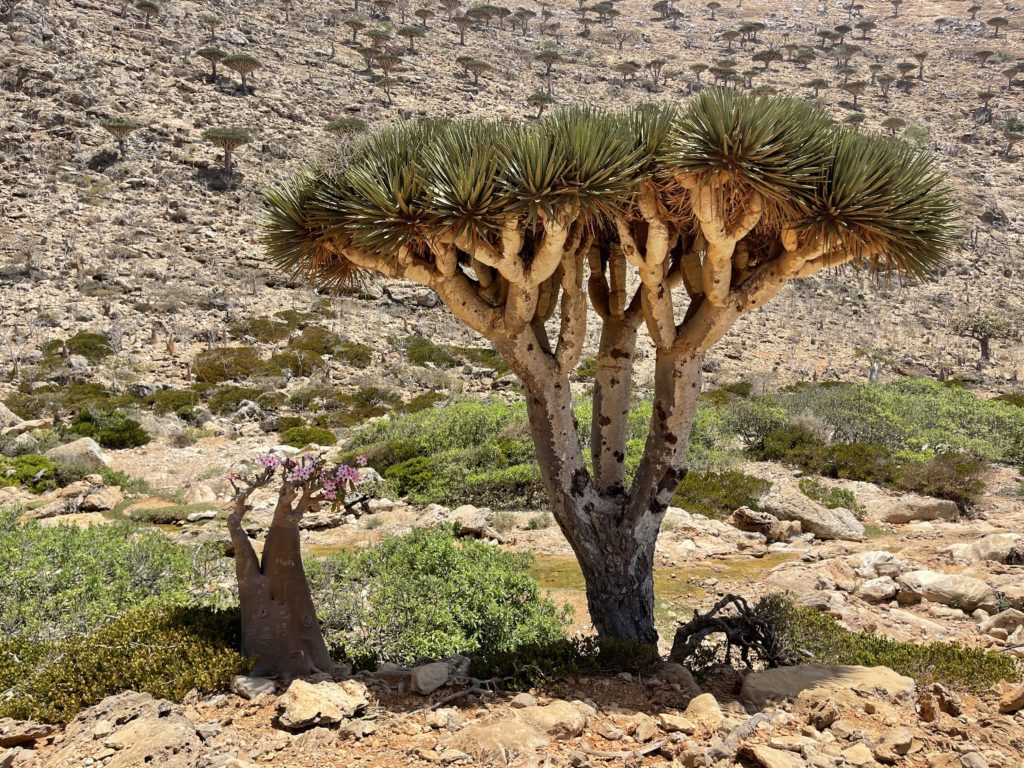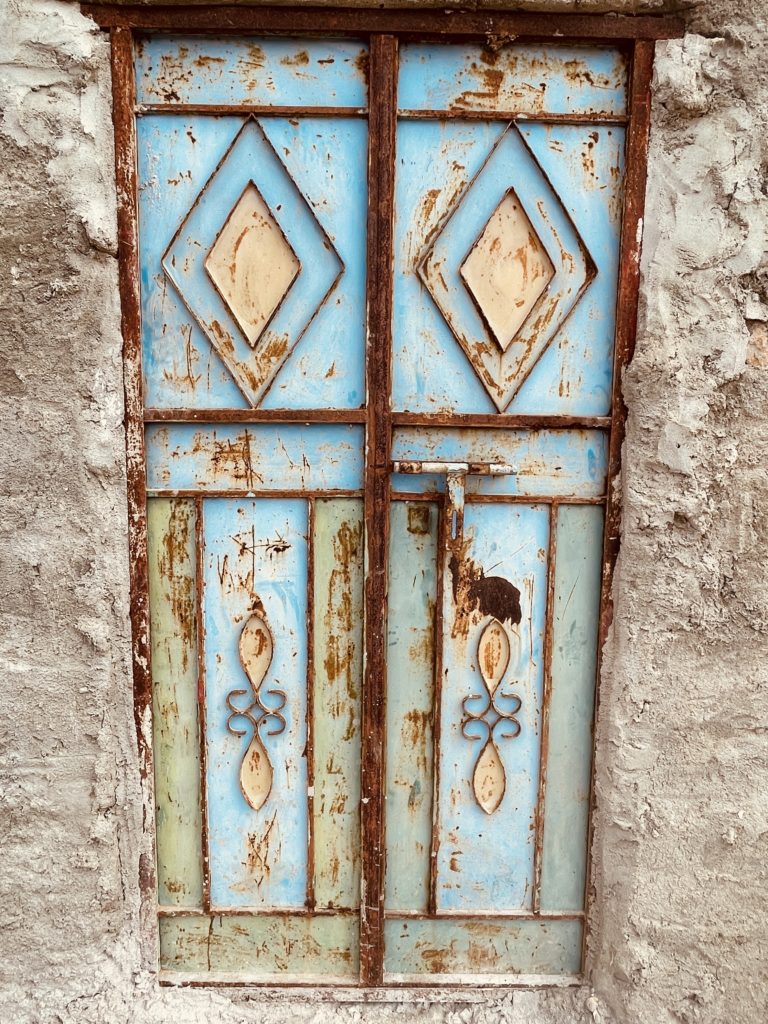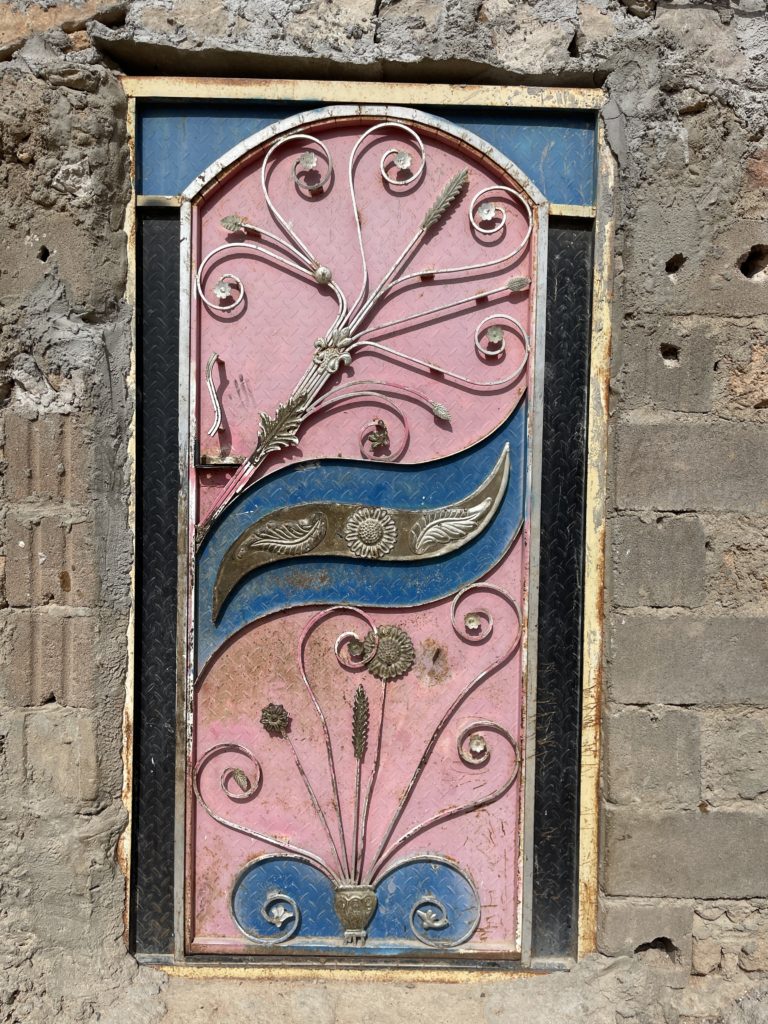Day 5 Hoq Cave, Arher beach and Ras Erissel
I was looking forward to today – a hike uphill to the very deep Hoq Cave. Many of the tourists skip it in may due to the heat, and the guide book said it was about 2 hours to get there, but also that it was 3km and 350m of hiking to the cave entrance, so I was pretty confident we would get there in an hour or less. We parked at a village and there were three women there in full black abbayas who were also planning to hike. I kept a headscarf and skirt on for the first 100m and the stuffed them in my bag when out of sight of the ladies as It was ferociously hot. I was in shorts and t-shirt and was soaking wet after 20 minutes. But the views were absolutely stunning. And there were lots of gorgeous bottle trees in flower as well as Stercula Africana. Our local guide Abdullah bounded up the mountain, and we only stopped for a short break in the shade, and I made it to the top in 47 minutes with Steph a few minutes behind. It was very hot. The cave was enormous, with excellent stalagtites ad stalagmites, but the highlight for me was the walk up and down. However the cave did provide a respite from the heat. The three Yemeni ladies took a full two hours and change to get up the hill – but they must have been cooking in all the layers of clothing. They had run out of water so we gave them some and a snack. When we got back to the car, Ahmed had cooked us lovely fish, rice and potatoes, so we sat in the shade and fended off the goats while eating.





















Next stop was the Arher dunes which were phenomenal. We stopped as a fresh water creek came through a crack in the dunes and flowed into the ocean. It was Friday so the beach was ‘crowded’ (probably 50 people) with locals who had come for the night with all the camping gear. The women didn’t seem to be swimming (and were in full niqabs), but the kids were loving it. It was definitely the best beach swim of the trip.







And finally we went to the end of the island to Ras Erissel – a spit of land that is wind blasted by the Indian Ocean to the south and the Arabian ocean to the north. There were hundreds of dead puffer fish, which are lethal to your feet (even through sandals with their sharp spikes), they die as they like to swim close to the shore but the waves often crash them down on the sea shore. It was hot and with fiery winds, so we retreated to the AC in the 4wd and meandered back to Hadibo taking photos of some shipwrecks on the way. Dinner was at the local – chicken, beans, liver and bread, and we made sure the local kitten was well fed and watered (she was fiesty and hissed at the goat)






Day 6 – Killisan, Qaria and Dihamri
Billed as a tough hike, we headed for the best swimming pool on Socotra – in Wadi Killisan. The trail head was 90 minutes from Hadibo, and while the guide book said it was c. 45 mins each way on a goat track to the pools from the start, it was about 20 mins each way on a well made (by kiwi standards) path, measuring 1.1km each way with 100m of descent/ascent. There was another car at the trailhead, which was disappointing as meant we might have company, but we met the couple who belonged to the car climbing the trail – which meant we had the pools to ourselves. Or we did until 5 adorable boys who had walked a couple of hours from a nearby village arrived and started practicing English on us. The kids here are very low key, they don’t ask for money or anything, and they are happy (in most cases, as I always ask first) to have their photos taken.




















We played around in the pools for an hour, swimming, and watching the boys somersault off the steep sides of the wadi. The Steph and I walked up and down both sides of the wadi taking photos of the waterfalls and the rocks, before swimming again. We headed up the path at 12.30 and Ahmed had prepared an excellent lunch for us. The kids were about 20 minutes behind us and were delighted to be the beneficiaries of a lot of leftovers (they didn’t ask, we offered, but they hadn’t bought any food with them, and Ahmed always cooks a lot).






I had already had a perfect day, but we headed to Dihamri to see the nature reserve. Sadly there was a lot of rubbish, and it was baking hot, so we passed on snorkelling. We then headed to Qaria village to take photos of the lagoon and meet some local kids.








Day 7 Homhil and Hadibo
It was another baking hot morning and I had an early breakfast and sat in the AC’d reception piggy backing on the managers phones wifi to read the Sunday papers. Ahmed and Ali arrived at 8 and we did our tour of the local market to buy lunch ingredients. It is hilarious as Ahmed just drives around shouting out the window what he wants and people bring it – Yemen has drive through/ drive by shopping.
We headed east and stopped at Ali’s village in Qaria for tea. I went to the womens room with his mum, wife and two sisters in law and all the kids – about 6 at the beginning and probably 14 by the time I left, as they had all heard about the farangi in the house. My Arabic is woeful, but we had a lovely chat about Socotra and Ali the guide. They asked via hand signals why I didn’t have kids and I thought they were asking in hand signals if I wasn’t sleeping with my husband enough ( hand signals in English definitely have different meanings), but it turns out they were asking if I had a husband. They were impressed when Ali arrived and told them I had a job, and one of his sister in laws remarked that she would love to go to work and have her own money. They have no electricity, no internet, not much in the way of education, no way of changing their circumstances, but they were wonderfully hospitable, though I did get told I was being haram for not covering my mouth with my scarf when Ali came in the room (only eyes should be showing). While in town I dress appropriately (head scarf, long pants, long sleeved baggy long shirt), Ali has seen me in a swimsuit, so I wasn’t worried about him seeing my face.

Next stop we bumped up the homhil plateau. The 4wd needed all the juice so we had to turn the AC off. The plateau has all the delights of Socotra – red rock, dragon blood trees, bottle trees and lots of frankincense. Our local guide Saha (11) took us down the dry river to the infinity pool – a natural rock formation which creates a swimming pool with a view down 700m to the sea. Unfortunately it was a bit dry, but still enough water for a quick dip. We then ‘relaxed’ in the shade while the locals cooked our lunch.















We then headed back to Hadibo to visit the nursery where they are trying to conserve Dragon blood trees for future generations. The key thing is to keep the goats out of the walls. We also popped by the women’s centre which supports local women’s enterprise to try and spend some money. Sadly the bulk of the merchandise was clothes made for locals and large woven baskets. We bought some things we didn’t need I made a note to myself to send the NGO a note on improving their range (smaller tourist-oriented purchases) and increase their prices.







We then went shopping in Hadibo, where hubby bought a fouta (the belted skirt the local men wear) and a few scarfs for me (though amusingly I mostly bought the mens ones). We strolled around taking photos of the Hadibo doors and the amazing amounts of rubbish. It really doesn’t smell bad here as the rubbish is entirely plastic. The goats (literally hundreds of them) do an exceptional job eating all of the organic refuse. But the plastic has nowhere to go……, and o-one even notices it.





We had our final dinner at Shawarb, and bade farewell to the crew of Mohammed, Nafa and Abood. They were super friendly kids – ranging from 16 to 24. They all came to Socotra to escape mainland Yemen and they send money homes to their families. They work very hard, six days a week, sleep in a communal room at the back of the restaurant and share one bathroom. For this, they get free food and about $100 a month. They would all love to go to Europe where they could work hard for more money, but that is an unlikely proposition, so most of them keep smiling, work on their English and try to find joy in the day.



Additional info
Socotra is an odd place. Officially Yemen. The locals describe themselves as Socotri or from Yemen (but more the southern part). Civil servants haven’t been paid here regularly for years. National park rules are regularly infringed with people building in forbidden locations. Wild goats are everywhere and are destroying many of the endemic plant species (c. 70% of the plant and 90% of the reptile species are only found on Socotra). Municipal rubbish collection is non existent (and there is rubbish everywhere). We saw a ten year old with younger kids driving a land rover through town – our guide said that wouldn’t have happened before the war, but now no one enforces most of the rules. The Emirates and the Saudis would both like to take control. Both have invested in building schools on the island (often funding two separate schools in a single small village). However the Emirates seem to be in pole position as they are currently paying the police (at least sporadically and apparently only about usd60 per month) and running the airport and have had local military posts since 2020. They also run the main petrol station where you have to pay in dirhams (not Yemeni rials). But effectively it is a lawless state. What (I think) keeps it together for now is that the 60,000 socotri all know each other and keep the peace and deal with any major issues between themselves. But there have been c 40k immigrants from the mainland who don’t speak the local language and will likely change the culture and norms. The locals are fiercely proud of their island and their culture, but lots of them would like to try and get work elsewhere. Even our hard working guide and driver only work 4 months of the year, as there is no tourists for much of the year (weather and the planes don’t fly) . But they can’t leave Yemen – visas are hard to come by. European countries apparently need proof of wealth, but no Yemeni will put their money in Yemens banks as they aren’t reliable (and they store currency in USD at 1/3 of the freely available black market rate). It will be interesting to see what happens over the coming decade.
If I came again, I would do more hiking. I would come in October or March, bring a good free standing tent (with a 100% mesh inner), a water filter and some dehydrated meals. There are no gas canisters here but you can buy fuel for an alcohol stove. Good hikes would be up the Wadi Killisan from Khor Matyaf (water available from the wadi), and also the route described in the camel trek in the Bradt guide (though you wouldn’t need camels as you could filter water and carry your own gear).
We stayed in Hadibo every night as Steph isn’t a fan of camping. Having seen the rubbish at the ‘campsites’, the quality of the tents and in many cases the absence of fresh water to swim in, I would definitely not do the camping tours – but lots of big tour groups seem to enjoy it.
We bought the Bradt guide to Socotra – you don’t really need a guide, but it was nice to read and get some background. Also hats off to the authors who were respectively 78 and 81 when they camped their way around the island to write the guide.
Hadibo, 9 May 2022
The foliage is extraordinary, the trunks and the tiny little branches. I would have spent hours looking at them. The bulbous shape is so cool. The people are so beautiful, there big brown eyes melt my heart. Love your stories. xx
Glad to see this; I think we were there at the same time, glad you enjoyed it as well!